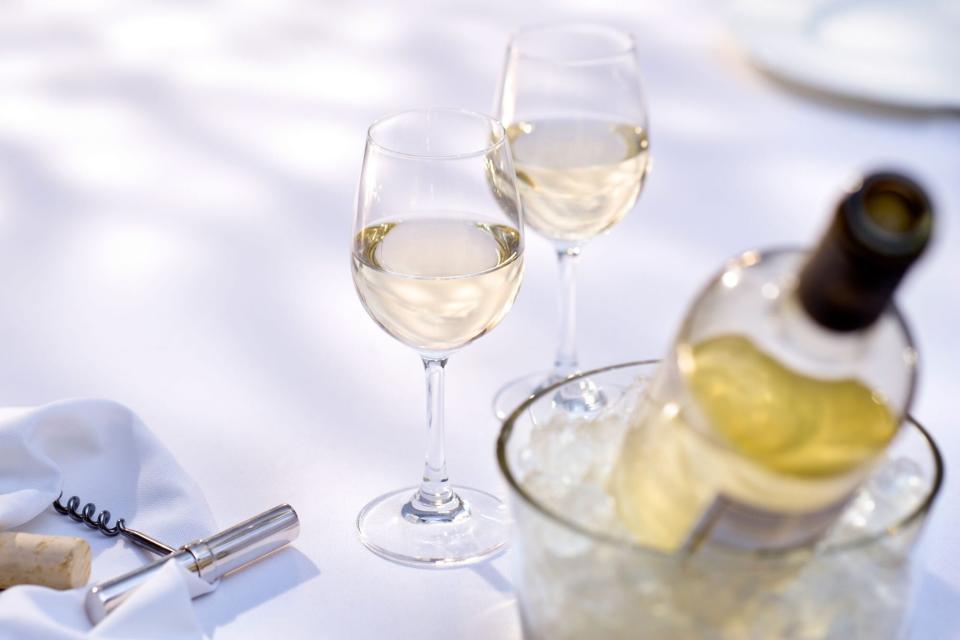Why You Shouldn't Overchill Wine—Plus, How to Know If You Are
Sipping a bottle of chilled wine with friends is, without a doubt, one of the most enjoyable ways to pass a summer evening. Warm-ish wine is decidedly less enticing. But what about overchilled wine—is there such a thing? And can too much of a chill ruin your treasured vino and the drinking experience?
"Temperature is a critical factor. The effects of serving temperatures on the flavor of a wine cannot be overstated," says Chevonne Ball, a certified sommelier, French Wine Scholar, and owner of Dirty Radish, which hosts private wine tastings, wine events, and wine tours in Willamette Valley and Portland, Oregon, and in Beaujolais, among other French regions. "Serving a wine at the right temp can seem ridiculously high-falutin' and luxurious as a pastime, but it can genuinely turn ink into velvet and zest into flab," she explains.

MarkSwallow / Getty Images
The Cold Front
So, what happens when wine meets the big chill? If the temperature is too cold, the wine can freeze and expand, forcing out the cork or breaking the bottle, allowing a whoosh of oxygen into the wine. Champagne in particular can turn into a cautionary tale if you pop it in the freezer for too long a spell. "No sparklers in the freezer—they have CO2, so they will explode. It won't end well!" says Ball.
There are other reasons to steer clear of tundra-like conditions. "If you serve the wine too cold, you'll miss out on its acidity, fruit structure, and sweetness," says Ball. "Too much refrigeration can greatly influence the taste of the wine." On the other end of the temperature scale, a wine that's served too warm can smack of alcohol and bitterness.
Ideal Temperature Ranges
There are optimal temperatures at which wine should be served. Champagne, everyone's favorite celebratory libation, tastes best when chilled between 47°F and 50°F, notes Ball. Crisp white wines high in acidity, such as sauvignon blanc, should fall in the 45°F to 50°F range, while whites with more body, like a good Chardonnay, are best at 50°F to 55°F. "You also have the option to chill red wine—specifically Gamay, wines from the Loire Valley, pinot noir, Nero d'Avola from Italy," says Ball. All they need is about 20 minutes in the fridge before serving. Wine labels are also highly instructive, she adds, offering details as to the ideal serving temperature.
And there are other factors that contribute to the experience, like who you're sharing the bottle with and how the wine is stored. "If you don't have a cellar or a wine fridge, store it in a darker place in your home—not on top of the fridge." Kitchen refrigerator, wine fridge, a dark cabinet—wherever you keep it, ultimately the bottle should be cool to the touch. "A bottle of wine is a living, breathing thing. It's aging every day," says Ball. "It's constantly shifting. Storing, chilling, serving, are all part of its life. It starts with storing it properly. After that, you can manipulate it for the right temperature."
Last-Minute Chills
The reason to chill the wine, after all, is so that when it's out on the table, it won't get too warm too fast. Ball says that in the South of France, famous for its hot, dry Mediterranean climate, it's not uncommon to put an ice cube in a glass of rosé. And, of course, there are quick-fix ways to get a chill on whites, rosés, and reds, like popping the bottles into a bucket of ice, and sprinkling kosher salt on the ice to speed up the process.
Basically, it's finding that sweet spot for wines. "It's summer. We are all going to be on patios," she says. Sipping perfectly chilled wines, of course.

